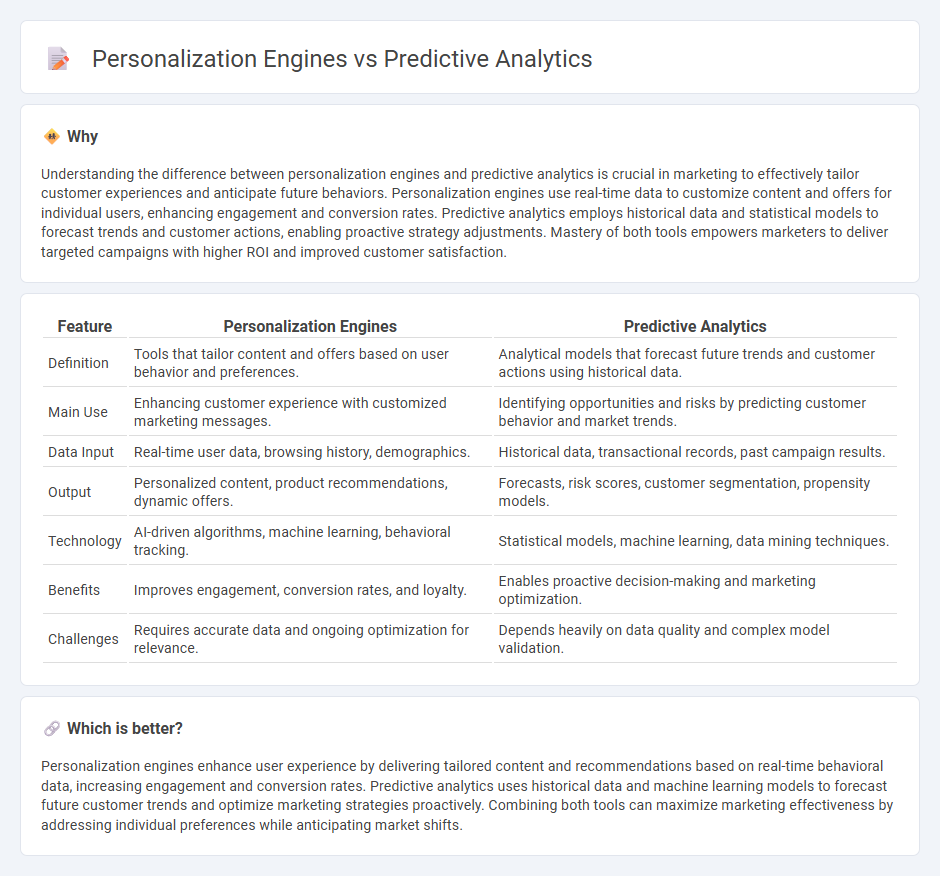
Personalization engines utilize real-time data to tailor content and offers specifically to individual user behaviors, enhancing customer engagement through customized experiences. Predictive analytics employs historical data and machine learning models to forecast future trends and customer actions, enabling proactive marketing strategies and optimized resource allocation. Explore how integrating these technologies can drive more precise marketing outcomes and boost ROI.
Why it is important
Understanding the difference between personalization engines and predictive analytics is crucial in marketing to effectively tailor customer experiences and anticipate future behaviors. Personalization engines use real-time data to customize content and offers for individual users, enhancing engagement and conversion rates. Predictive analytics employs historical data and statistical models to forecast trends and customer actions, enabling proactive strategy adjustments. Mastery of both tools empowers marketers to deliver targeted campaigns with higher ROI and improved customer satisfaction.
Comparison Table
| Feature | Personalization Engines | Predictive Analytics |
|---|---|---|
| Definition | Tools that tailor content and offers based on user behavior and preferences. | Analytical models that forecast future trends and customer actions using historical data. |
| Main Use | Enhancing customer experience with customized marketing messages. | Identifying opportunities and risks by predicting customer behavior and market trends. |
| Data Input | Real-time user data, browsing history, demographics. | Historical data, transactional records, past campaign results. |
| Output | Personalized content, product recommendations, dynamic offers. | Forecasts, risk scores, customer segmentation, propensity models. |
| Technology | AI-driven algorithms, machine learning, behavioral tracking. | Statistical models, machine learning, data mining techniques. |
| Benefits | Improves engagement, conversion rates, and loyalty. | Enables proactive decision-making and marketing optimization. |
| Challenges | Requires accurate data and ongoing optimization for relevance. | Depends heavily on data quality and complex model validation. |
Which is better?
Personalization engines enhance user experience by delivering tailored content and recommendations based on real-time behavioral data, increasing engagement and conversion rates. Predictive analytics uses historical data and machine learning models to forecast future customer trends and optimize marketing strategies proactively. Combining both tools can maximize marketing effectiveness by addressing individual preferences while anticipating market shifts.
Connection
Personalization engines leverage predictive analytics to analyze customer data and forecast behaviors, enabling tailored marketing strategies that increase engagement and conversion rates. By interpreting patterns in consumer interactions, predictive analytics provide insights that drive the dynamic content delivery within personalization engines. This integration enhances the effectiveness of marketing campaigns through data-driven customization and timely customer targeting.
Key Terms
Machine Learning
Predictive analytics leverages Machine Learning algorithms to analyze historical data and forecast future trends, enhancing decision-making accuracy across industries. Personalization engines utilize similar Machine Learning techniques to tailor user experiences by predicting individual preferences and behaviors in real time. Explore deeper insights on how these technologies transform business strategies and customer engagement.
Customer Segmentation
Predictive analytics uses historical data and machine learning algorithms to identify patterns and forecast customer behavior, enabling precise customer segmentation. Personalization engines leverage these segments to deliver tailored content, recommendations, and experiences that enhance customer engagement and satisfaction. Explore how advanced customer segmentation strategies can transform your marketing efforts and drive growth.
Recommendation Systems
Recommendation systems leverage predictive analytics to forecast user preferences and deliver personalized content by analyzing historical data, behavior patterns, and contextual information. Personalization engines enhance these predictions by dynamically adjusting recommendations based on real-time user interactions and feedback, creating a tailored experience across multiple touchpoints. Explore how combining advanced predictive models with adaptive personalization techniques drives more accurate and relevant recommendation systems.
Source and External Links
What is Predictive Analytics? | IBM - Predictive analytics uses historical data combined with statistical modeling, data mining, and machine learning to identify patterns and predict future outcomes for risk management and opportunity discovery in businesses.
What is predictive analytics and how does it work? | Google Cloud - Predictive analytics forecasts future outcomes by analyzing data with machine learning, AI, and statistical models, often using classification and regression techniques to predict behaviors and trends.
A Guide To Predictive Analytics - Tableau - Predictive analytics leverages techniques like data mining, statistics, AI, and machine learning to interpret past data and identify risks and opportunities, helping organizations anticipate future outcomes proactively.
 dowidth.com
dowidth.com